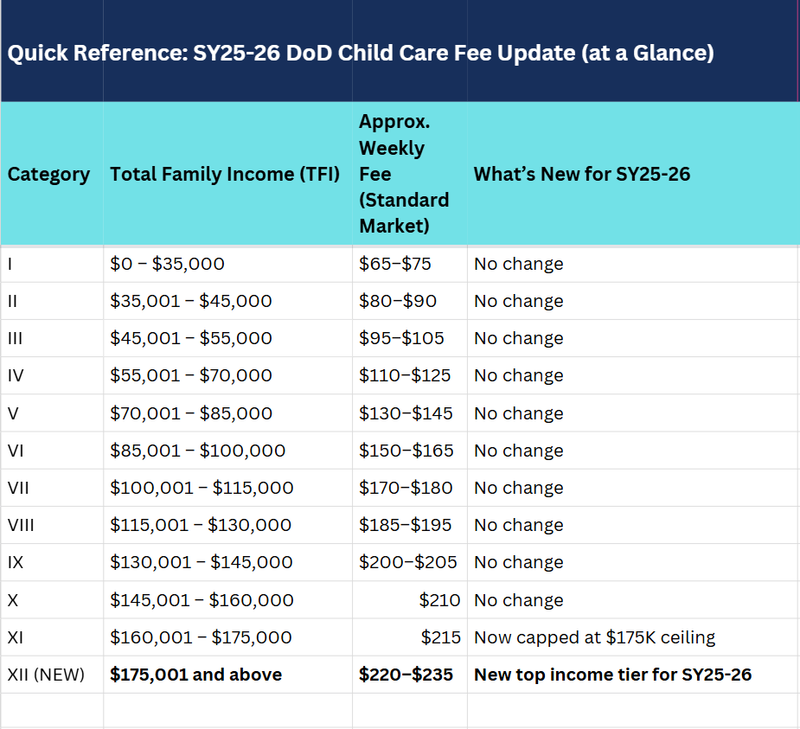YOUR CHILD CARE BILL JUST CHANGED: WHAT SY25-26 DOD FEE UPDATES MEAN FOR MILITARY FAMILIES

ADVERTISEMENT
For many military families, child care is essential because it keeps everything else running smoothly. When care costs go up or availability changes, it can disrupt a family’s entire routine. This fall, the Department of Defense (DoD) announced new rates and a major change for School Year 2025–26: a new top income tier that affects thousands of households, which went into effect on November 1st.
Here’s what’s changed, who’s affected, and how to make sure your family doesn’t pay more than you have to. Review your current fees and contact your local CDC or Family Child Care office to clarify your expected updates.
What’s Changing in SY25-26
The DoD has added a 12th fee category for families with a Total Family Income (TFI) above $175,000. This new top tier, called Category XII, joins the existing 11 categories used to calculate child care rates.
TFI includes all income earned by both parents, plus allowances such as Basic Allowance for Housing (BAH) in certain locations. These brackets determine what families pay for child care at Child Development Centers (CDCs), school-age care programs, and certified Family Child Care homes across all military branches.
The fee structure still depends on your installation’s cost of living, which may be standard, low, or high market adjustment. Families in higher income brackets can expect to pay a bit more this year. According to the DoD, this change is meant to keep child care affordable for lower-earning families while reflecting higher market costs for higher-income families.
Nobody Prepared You for Military Life
But we can help. Join over 100k spouses already getting the specific advice, resources, and military tea they need to thrive.
Why the DoD Made the Change
The new category is part of an effort to improve equity and sustainability across the DoD’s child development programs. The last major update expanded subsidies and froze some increases during COVID. Now, as inflation and staffing costs climb, the Pentagon says it must recalibrate rates to ensure the programs stay fully staffed and high-quality.
Simply put, the new category helps share the cost more fairly. Families with the highest incomes will pay a little more, which helps keep rates lower for families with midrange or lower incomes. It’s a balancing act meant to protect both affordability and access. Many military parents are already familiar with this challenge.
How to Estimate Your New Rate
Check your latest LES and spouse pay stubs, and add allowances included in TFI.
Use your installation’s rate chart to find your category. For example, a $178,000 TFI at a standard market installation places your family in Category XII for SY25-26.
In previous years, Category XI families (TFI above $160,001) paid about $215 per child weekly. Category XII will be a bit higher, depending on your market rate.
You should also check if your installation uses a high-market adjustment, which can add 10 to 15 percent to the standard rate. A quick call to your CDC or School-Age Care office can tell you which category applies to your location.
Ways to Offset Higher Costs
There are several ways to lower your overall child care costs. Take time now to review your eligibility and upcoming deadlines so you don’t miss out on key savings opportunities.
ADVERTISEMENT
1. Apply for the DoD Fee Assistance Program.
If your installation is full or you’re stationed somewhere without an on-base option, you may qualify for the Child Care Fee Assistance Program through Child Care Aware of America. It helps cover the cost difference between what you’d pay at a CDC and a licensed off-base provider.
2. Use your Dependent Care Flexible Spending Account (DCFSA).
Many military families are newly eligible to participate in DCFSA. You can set aside up to $5,000 in pre-tax income annually to offset child care costs. It’s one of the easiest ways to save without adjusting your budget.
3. Ask about temporary hardship waivers.
If your income drops suddenly because of deployment, medical leave, or job loss, installations can approve short-term fee adjustments or waivers. You’ll need to submit documentation, but it’s worth asking.
ADVERTISEMENT
4. Verify sibling discounts or multi-child rate adjustments.
Some installations offer small reductions for families with more than one child enrolled. Even a few dollars per week can add up over time.
How This Impacts Military Spouses
For military spouses who work full-time or are trying to return to work, child care is more than just an expense; it is essential for maintaining a career. The new DoD fee policy does not remove that challenge, but it does recognize the growing number of dual-income military households and the need for consistency across installations.
When rates change, it’s easy to feel frustrated or powerless. But understanding the structure helps you plan better. If your family is moving or changing jobs this year, use the SY25-26 policy as a budgeting checkpoint rather than a surprise bill.
The best thing you can do now is stay informed, plan early, and use every available support program. The DoD’s updated fee structure is not just about numbers. It is about keeping child care accessible for the families who keep our force ready. For military spouses balancing home, work, and everything in between, that access makes a real difference.
When your child is cared for, your mission at home and beyond can continue.

Suggested reads:

Veteran & Senior Contributor, Military News
BY NATALIE OLIVERIO
Navy Veteran
Natalie Oliverio is a Navy Veteran, journalist, and entrepreneur whose reporting brings clarity, compassion, and credibility to stories that matter most to military families. With more than 100 published articles, she has become a trusted voice on defense policy, family life, and issues shaping the ...
Credentials
- Navy Veteran
- 100+ published articles
- Veterati Mentor
- Travis Manion Foundation Mentor
- Journalist and entrepreneur
Expertise
ADVERTISEMENT
ADVERTISEMENT



